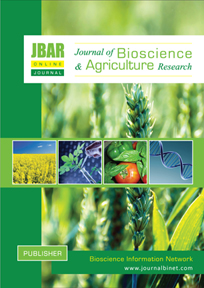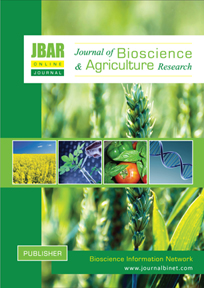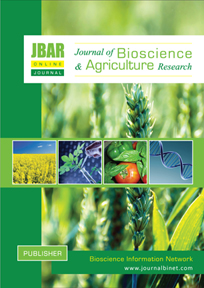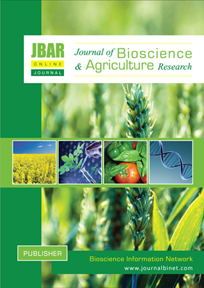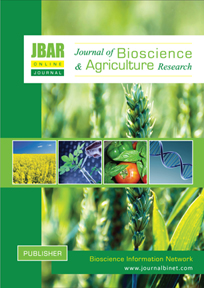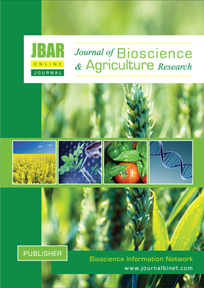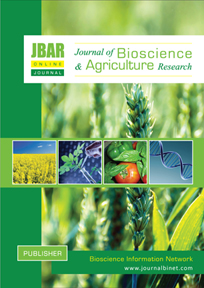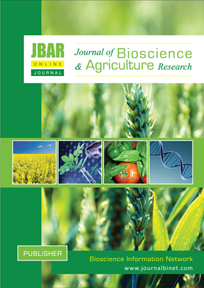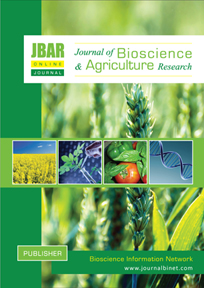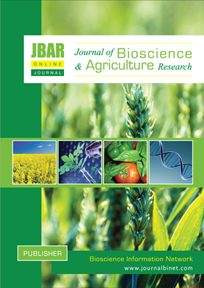Journal of Bioscience and Agriculture Research
Volume 10 - Issue 01 | Year of Publication: 2016
Article Type: Research Article | No. 101, 2016 | Country: Bangladesh | pp. 837-842 | Open Access | Downloads:
Title: Vase life improvement of yellow gladiolus through different preservative solutions
Authors: Jamal Uddin, A. F. M., Shamsuzzoha, M., Nusrat, A., Taufique,T. & Mehraj, H.
DOI: http://dx.doi.org/10.18801/jbar.100116.101
Title: Vase life improvement of yellow gladiolus through different preservative solutions
Authors: Jamal Uddin, A. F. M., Shamsuzzoha, M., Nusrat, A., Taufique,T. & Mehraj, H.
DOI: http://dx.doi.org/10.18801/jbar.100116.101
Title: Vase life improvement of yellow gladiolus through different preservative solutions
Abstract: An experiment was conducted to find out the suitable preservative solution which provides the longest vase life for yellow gladiolus against eight preservative solutions coded from T0 to T7 and these were T1: 100-ppm silvar thiosulphate (STS); T2: 3% sucrose + 100-ppm citric acid (CA); T3: 3% sucrose + 100-ppm salicylic acid (SA); T4: 3% sucrose + 100-ppm STS; T5: 5% sucrose + 100-ppm CA; T6: 5% sucrose + 100-ppm SA; T7: 5% sucrose + 100-ppm STS with T0: Control (Tap water). T4 treatment provided maximum spike diameter (13.9 mm) and floret opening (96.8%) at 12th days after treating, maximum days to basal floret senescence (12.4), maximum no. of floret open during basal floret senescence (10.5), maximum solution absorption (47.8 ml/spike), maximum vase life (21.5 days) with minimum fresh weight loss (25.1%) and floret wilting (29.3%) at 12th days after treating which was closely followed by T3. However, incidence of stem rotting was not in T2, T3 and T4. Blend solutions of STS/SA (100-ppm) and 3% sucrose is recommended to use for the maximization of the postharvest life of yellow gladiolus.
Key Words: Gladiolus, Preservative solutions and Vase life
Abstract: An experiment was conducted to find out the suitable preservative solution which provides the longest vase life for yellow gladiolus against eight preservative solutions coded from T0 to T7 and these were T1: 100-ppm silvar thiosulphate (STS); T2: 3% sucrose + 100-ppm citric acid (CA); T3: 3% sucrose + 100-ppm salicylic acid (SA); T4: 3% sucrose + 100-ppm STS; T5: 5% sucrose + 100-ppm CA; T6: 5% sucrose + 100-ppm SA; T7: 5% sucrose + 100-ppm STS with T0: Control (Tap water). T4 treatment provided maximum spike diameter (13.9 mm) and floret opening (96.8%) at 12th days after treating, maximum days to basal floret senescence (12.4), maximum no. of floret open during basal floret senescence (10.5), maximum solution absorption (47.8 ml/spike), maximum vase life (21.5 days) with minimum fresh weight loss (25.1%) and floret wilting (29.3%) at 12th days after treating which was closely followed by T3. However, incidence of stem rotting was not in T2, T3 and T4. Blend solutions of STS/SA (100-ppm) and 3% sucrose is recommended to use for the maximization of the postharvest life of yellow gladiolus.
Key Words: Gladiolus, Preservative solutions and Vase life
APA (American Psychological Association)
Jamal Uddin, A. F. M., Shamsuzzoha, M., Nusrat, A., Taufique,T. & Mehraj, H. (2016). Vase life improvement of yellow gladiolus through different preservative solutions. Journal of Bioscience and Agriculture Research, 10(01), 837-842.
MLA (Modern Language Association)
Jamal Uddin, A. F. M., Shamsuzzoha, M., Nusrat, A., Taufique,T. & Mehraj, H. "Vase life improvement of yellow gladiolus through different preservative solutions". Journal of Bioscience and Agriculture Research, 10.01 (2016), 837-842.
Chicago/Turabian
Jamal Uddin, A. F. M., Shamsuzzoha, M., Nusrat, A., Taufique,T. & Mehraj, H. Vase life improvement of yellow gladiolus through different preservative solutions. Journal of Bioscience and Agriculture Research, 10, no. 01 (2016), 837-842.
Jamal Uddin, A. F. M., Shamsuzzoha, M., Nusrat, A., Taufique,T. & Mehraj, H. (2016). Vase life improvement of yellow gladiolus through different preservative solutions. Journal of Bioscience and Agriculture Research, 10(01), 837-842.
MLA (Modern Language Association)
Jamal Uddin, A. F. M., Shamsuzzoha, M., Nusrat, A., Taufique,T. & Mehraj, H. "Vase life improvement of yellow gladiolus through different preservative solutions". Journal of Bioscience and Agriculture Research, 10.01 (2016), 837-842.
Chicago/Turabian
Jamal Uddin, A. F. M., Shamsuzzoha, M., Nusrat, A., Taufique,T. & Mehraj, H. Vase life improvement of yellow gladiolus through different preservative solutions. Journal of Bioscience and Agriculture Research, 10, no. 01 (2016), 837-842.
Article Type: Research Article | No. 102, 2016 | Country: Bangladesh | pp. 843-847 | Open Access | Downloads:
Title: Screening of salinity tolerance of rice at early seedling stage
Authors: Mondal, S & Borromeo, T. H.
DOI: http://dx.doi.org/10.18801/jbar.100116.102
Title: Screening of salinity tolerance of rice at early seedling stage
Authors: Mondal, S & Borromeo, T. H.
DOI: http://dx.doi.org/10.18801/jbar.100116.102
Title: Screening of salinity tolerance of rice at early seedling stage
Abstract: The study was conducted at International Rice Research Institute (IRRI) to assess the response of dry season hybrid seeds including parental checks FL478 and NSIC Rc222 to salt tolerance (12 dS/m) at the seedling stage of rice using IRRI screening techniques. The total number of seeds were two hundred thirty-one and irrigated, flood prone, heat tolerance, salinity and problem soils, aerobic and anaerobic germination, rainfed lowland and South Asian samples were used for this experiment. Among them, only 1.73% populations (4 irrigated) were identified as tolerant, 18.18% moderately tolerant, 37.26% sensitive and 46.86% were highly sensitive. Moderately tolerant plants were found from irrigated, flood prone, salinity and problem soils, aerobic germination, anaerobic germination and rainfed lowland and South Asian genotypes. As there was Brown Plant Hopper (BPH) infestation in this experiment, the tolerant genotypes may also be tolerant to BPH and for that reason results were distorted for other genotypes. Therefore, study should be conducted under controlled environment to ascertain the level of salt tolerance of the moderately tolerant populations. Besides, the identified tolerant genotypes (4) should be further tested with 18 dS/m to determine their supremacy to salt tolerance at the seedling and reproductive stages and QTL analysis could be performed to determine the effects of each genomic region of the trait of interest.
Key Words: Salinity tolerance, Seedling stage, IRRI, FL478 and NSIC Rc222
Abstract: The study was conducted at International Rice Research Institute (IRRI) to assess the response of dry season hybrid seeds including parental checks FL478 and NSIC Rc222 to salt tolerance (12 dS/m) at the seedling stage of rice using IRRI screening techniques. The total number of seeds were two hundred thirty-one and irrigated, flood prone, heat tolerance, salinity and problem soils, aerobic and anaerobic germination, rainfed lowland and South Asian samples were used for this experiment. Among them, only 1.73% populations (4 irrigated) were identified as tolerant, 18.18% moderately tolerant, 37.26% sensitive and 46.86% were highly sensitive. Moderately tolerant plants were found from irrigated, flood prone, salinity and problem soils, aerobic germination, anaerobic germination and rainfed lowland and South Asian genotypes. As there was Brown Plant Hopper (BPH) infestation in this experiment, the tolerant genotypes may also be tolerant to BPH and for that reason results were distorted for other genotypes. Therefore, study should be conducted under controlled environment to ascertain the level of salt tolerance of the moderately tolerant populations. Besides, the identified tolerant genotypes (4) should be further tested with 18 dS/m to determine their supremacy to salt tolerance at the seedling and reproductive stages and QTL analysis could be performed to determine the effects of each genomic region of the trait of interest.
Key Words: Salinity tolerance, Seedling stage, IRRI, FL478 and NSIC Rc222
APA (American Psychological Association)
Mondal, S & Borromeo, T. H. (2016). Screening of salinity tolerance of rice at early seedling stage. Journal of Bioscience and Agriculture Research, 10(01), 843-847.
MLA (Modern Language Association)
Mondal, S & Borromeo, T. H. "Screening of salinity tolerance of rice at early seedling stage". Journal of Bioscience and Agriculture Research, 10.01 (2016), 843-847.
Chicago/Turabian
Mondal, S & Borromeo, T. H. Screening of salinity tolerance of rice at early seedling stage. Journal of Bioscience and Agriculture Research, 10, no. 01 (2016), 843-847.
Mondal, S & Borromeo, T. H. (2016). Screening of salinity tolerance of rice at early seedling stage. Journal of Bioscience and Agriculture Research, 10(01), 843-847.
MLA (Modern Language Association)
Mondal, S & Borromeo, T. H. "Screening of salinity tolerance of rice at early seedling stage". Journal of Bioscience and Agriculture Research, 10.01 (2016), 843-847.
Chicago/Turabian
Mondal, S & Borromeo, T. H. Screening of salinity tolerance of rice at early seedling stage. Journal of Bioscience and Agriculture Research, 10, no. 01 (2016), 843-847.
Article Type: Research Article | No. 103, 2016 | Country: Bangladesh | pp. 848-856 | Open Access | Downloads:
Title: Effects of protein levels on growth of Monosex Tilapia (Oreochromis niloticus Linnaeus, 1758) fry in nursery ponds of Bangladesh
Authors: Samad, M. A., Mimi, S. H., Paul, A. K. & Reza, M. S.
DOI: http://dx.doi.org/10.18801/jbar.100116.103
Title: Effects of protein levels on growth of Monosex Tilapia (Oreochromis niloticus Linnaeus, 1758) fry in nursery ponds of Bangladesh
Authors: Samad, M. A., Mimi, S. H., Paul, A. K. & Reza, M. S.
DOI: http://dx.doi.org/10.18801/jbar.100116.103
Title: Effects of protein levels on growth of Monosex Tilapia (Oreochromis niloticus Linnaeus, 1758) fry in nursery ponds of Bangladesh
Abstract: An experiment was conducted for a period of 60 days to evaluate the effect of protein levels on growth performance, survivability and water quality parameters of monosex tilapia (Oreochromis niloticus) fry. The experiment was conducted under three treatments of dietary protein levels viz. T1: 22% protein level; T2: 24% protein level and T3; 26% protein level with three replication each. Stocking density (249964 fish fry/ha) and initial weight 0.13±00g of fish was same in all treatments. Water quality parameter such as water temperature, dissolved oxygen, transparency, pH, alkalinity measured fortnightly. Mean value of water quality parameters showed no significant differences (P>0.05) among the treatments. Result showed that fry growth was significantly affected by protein level. The highest mean final weight gain was 26.79±1024g in T3 and lowest mean weight gain was 16.23±0.21g in T1. SGR (%, bwd-1)and FCR values showed significantly (P<0.05) different among the treatments. Feed with 30% protein level resulted in the highest production (P<0.05) in the T3 treatments.
Key Words: Oreochromis niloticus, Survivability, Monosex and Water qualit
Abstract: An experiment was conducted for a period of 60 days to evaluate the effect of protein levels on growth performance, survivability and water quality parameters of monosex tilapia (Oreochromis niloticus) fry. The experiment was conducted under three treatments of dietary protein levels viz. T1: 22% protein level; T2: 24% protein level and T3; 26% protein level with three replication each. Stocking density (249964 fish fry/ha) and initial weight 0.13±00g of fish was same in all treatments. Water quality parameter such as water temperature, dissolved oxygen, transparency, pH, alkalinity measured fortnightly. Mean value of water quality parameters showed no significant differences (P>0.05) among the treatments. Result showed that fry growth was significantly affected by protein level. The highest mean final weight gain was 26.79±1024g in T3 and lowest mean weight gain was 16.23±0.21g in T1. SGR (%, bwd-1)and FCR values showed significantly (P<0.05) different among the treatments. Feed with 30% protein level resulted in the highest production (P<0.05) in the T3 treatments.
Key Words: Oreochromis niloticus, Survivability, Monosex and Water qualit
APA (American Psychological Association)
Samad, M. A., Mimi, S. H., Paul, A. K. & Reza, M. S. (2016). Effects of protein levels on growth of Monosex Tilapia (Oreochromis niloticus Linnaeus, 1758) fry in nursery ponds of Bangladesh. Journal of Bioscience and Agriculture Research, 10(01), 848-856.
MLA (Modern Language Association)
Samad, M. A., Mimi, S. H., Paul, A. K. & Reza, M. S. "Effects of protein levels on growth of Monosex Tilapia (Oreochromis niloticus Linnaeus, 1758) fry in nursery ponds of Bangladesh". Journal of Bioscience and Agriculture Research, 10.01 (2016), 848-856.
Chicago/Turabian
Samad, M. A., Mimi, S. H., Paul, A. K. & Reza, M. S. Effects of protein levels on growth of Monosex Tilapia (Oreochromis niloticus Linnaeus, 1758) fry in nursery ponds of Bangladesh. Journal of Bioscience and Agriculture Research, 10, no. 01 (2016), 848-856.
Samad, M. A., Mimi, S. H., Paul, A. K. & Reza, M. S. (2016). Effects of protein levels on growth of Monosex Tilapia (Oreochromis niloticus Linnaeus, 1758) fry in nursery ponds of Bangladesh. Journal of Bioscience and Agriculture Research, 10(01), 848-856.
MLA (Modern Language Association)
Samad, M. A., Mimi, S. H., Paul, A. K. & Reza, M. S. "Effects of protein levels on growth of Monosex Tilapia (Oreochromis niloticus Linnaeus, 1758) fry in nursery ponds of Bangladesh". Journal of Bioscience and Agriculture Research, 10.01 (2016), 848-856.
Chicago/Turabian
Samad, M. A., Mimi, S. H., Paul, A. K. & Reza, M. S. Effects of protein levels on growth of Monosex Tilapia (Oreochromis niloticus Linnaeus, 1758) fry in nursery ponds of Bangladesh. Journal of Bioscience and Agriculture Research, 10, no. 01 (2016), 848-856.
Article Type: Research Article | No. 104, 2016 | Country: Bangladesh | pp. 857-865 | Open Access | Downloads:
Title: Integrated use of organic and inorganic fertilizers on the growth and yield of Boro rice (cv. BRRI dhan 29)
Authors: Sohel, M. H., Sarker, A., Razzak, M. A. & Hashem, M. A.
DOI: http://dx.doi.org/10.18801/jbar.100116.104
Title: Integrated use of organic and inorganic fertilizers on the growth and yield of Boro rice (cv. BRRI dhan 29)
Authors: Sohel, M. H., Sarker, A., Razzak, M. A. & Hashem, M. A.
DOI: http://dx.doi.org/10.18801/jbar.100116.104
Title: Integrated use of organic and inorganic fertilizers on the growth and yield of Boro rice (cv. BRRI dhan 29)
Abstract: A field experiment was conducted to evaluate the integrated effect of cow dung, poultry manure and water hyacinth with chemical fertilizers on the growth and yield of Boro rice (cv. BRRI dhan29). The effect of different levels of organic fertilizers in combination with recommended doses of inorganic fertilizers were tested over growth parameters and yield of rice.Among the yield contributing characters studied plant height, effective tillers hill-1, panicle length and filled grains panicle-1 were varied significantly by the different treatments. Most of the yield contributing characters influenced positively in treatment having quarter doses of cow dung, poultry manure and water hyacinth over recommended dose. The highest grain yield (5.58 t/ha)and straw yield (7.28 t/ha) were observed in that same treatmentT6 (1/3 Cow dung + 1/3 Poultry Manure + 1/3 water hyacinth + Fertilizers) over other treatments. Thus, the application of cow dung, poultry manure and water hyacinth with chemical fertilizers had significant and positive effect on N, P, K and S contents of rice.
Key Words: Organic fertilizer, Cow dung, Poultry manure and Water hyacinth
Abstract: A field experiment was conducted to evaluate the integrated effect of cow dung, poultry manure and water hyacinth with chemical fertilizers on the growth and yield of Boro rice (cv. BRRI dhan29). The effect of different levels of organic fertilizers in combination with recommended doses of inorganic fertilizers were tested over growth parameters and yield of rice.Among the yield contributing characters studied plant height, effective tillers hill-1, panicle length and filled grains panicle-1 were varied significantly by the different treatments. Most of the yield contributing characters influenced positively in treatment having quarter doses of cow dung, poultry manure and water hyacinth over recommended dose. The highest grain yield (5.58 t/ha)and straw yield (7.28 t/ha) were observed in that same treatmentT6 (1/3 Cow dung + 1/3 Poultry Manure + 1/3 water hyacinth + Fertilizers) over other treatments. Thus, the application of cow dung, poultry manure and water hyacinth with chemical fertilizers had significant and positive effect on N, P, K and S contents of rice.
Key Words: Organic fertilizer, Cow dung, Poultry manure and Water hyacinth
APA (American Psychological Association)
Sohel, M. H., Sarker, A., Razzak, M. A. & Hashem, M. A. (2016). Integrated use of organic and inorganic fertilizers on the growth and yield of Boro rice (CV. BRRI dhan 29). Journal of Bioscience and Agriculture Research, 10(01), 857-865.
MLA (Modern Language Association)
Sohel, M. H., Sarker, A., Razzak, M. A. & Hashem, M. A. "Integrated use of organic and inorganic fertilizers on the growth and yield of Boro rice (CV. BRRI dhan 29)". Journal of Bioscience and Agriculture Research, 10.01 (2016), 857-865.
Chicago/Turabian
Sohel, M. H., Sarker, A., Razzak, M. A. & Hashem, M. A. Integrated use of organic and inorganic fertilizers on the growth and yield of Boro rice (CV. BRRI dhan 29). Journal of Bioscience and Agriculture Research, 10, no. 01 (2016), 857-865.
Sohel, M. H., Sarker, A., Razzak, M. A. & Hashem, M. A. (2016). Integrated use of organic and inorganic fertilizers on the growth and yield of Boro rice (CV. BRRI dhan 29). Journal of Bioscience and Agriculture Research, 10(01), 857-865.
MLA (Modern Language Association)
Sohel, M. H., Sarker, A., Razzak, M. A. & Hashem, M. A. "Integrated use of organic and inorganic fertilizers on the growth and yield of Boro rice (CV. BRRI dhan 29)". Journal of Bioscience and Agriculture Research, 10.01 (2016), 857-865.
Chicago/Turabian
Sohel, M. H., Sarker, A., Razzak, M. A. & Hashem, M. A. Integrated use of organic and inorganic fertilizers on the growth and yield of Boro rice (CV. BRRI dhan 29). Journal of Bioscience and Agriculture Research, 10, no. 01 (2016), 857-865.
Article Type: Research Article | No. 105, 2016 | Country: Bangladesh | pp. 866-870 | Open Access | Downloads:
Title: Participatory evaluation of wheat genotypes under different tillage practice in Dinajpur, Bangladesh
Authors: Islam, M. M., Bashar, M. A., Akhter, N., Afroj, M., Rahman, M., Rahman, M. M. & Baque, M. A.
DOI: http://dx.doi.org/10.18801/jbar.100116.105
Title: Participatory evaluation of wheat genotypes under different tillage practice in Dinajpur, Bangladesh
Authors: Islam, M. M., Bashar, M. A., Akhter, N., Afroj, M., Rahman, M., Rahman, M. M. & Baque, M. A.
DOI: http://dx.doi.org/10.18801/jbar.100116.105
Title: Participatory evaluation of wheat genotypes under different tillage practice in Dinajpur, Bangladesh
Abstract: This study was conducted on a farmer field in Dinajpur district to facilitate farmer selecting their suitable wheat genotypes. It is needed for doing well in resource conserving tillage and also to find out the interaction between genotype and tillage in Rice-Wheat cropping system. The highest farmer score at post evaluation was obtained by BAW 1006 than other genotypes under studied mainly due to higher yield and good quality grain. Results demonstrated that BAW 1006 performed better in most of the tillage system, BAW 1008 in bed system and Shatabdi in strip. Data of percentage Diseased Leaf Area indicated that BAW 1006 was more infected by pests and diseases at conventional and power tiller operated seeder tillage system while more tolerant at bed planting spikes per square meter yield. The highest yield was recorded in conventional system followed by power tiller operated seeder, bed and the lowest at strip tillage. On the other hand, the highest yield was produced by BAW 1008 followed by BAW 1004, BAW 1006, Shatabdi, BAW 966 and Kanchan. BAW 1008 performed better in conventional bed and strip tillage where BAW 1006 and Shatabdi performed better in power tiller operated seeder system.
Key Words: Participatory evaluation, Wheat genotypes and Tillage systems.
Abstract: This study was conducted on a farmer field in Dinajpur district to facilitate farmer selecting their suitable wheat genotypes. It is needed for doing well in resource conserving tillage and also to find out the interaction between genotype and tillage in Rice-Wheat cropping system. The highest farmer score at post evaluation was obtained by BAW 1006 than other genotypes under studied mainly due to higher yield and good quality grain. Results demonstrated that BAW 1006 performed better in most of the tillage system, BAW 1008 in bed system and Shatabdi in strip. Data of percentage Diseased Leaf Area indicated that BAW 1006 was more infected by pests and diseases at conventional and power tiller operated seeder tillage system while more tolerant at bed planting spikes per square meter yield. The highest yield was recorded in conventional system followed by power tiller operated seeder, bed and the lowest at strip tillage. On the other hand, the highest yield was produced by BAW 1008 followed by BAW 1004, BAW 1006, Shatabdi, BAW 966 and Kanchan. BAW 1008 performed better in conventional bed and strip tillage where BAW 1006 and Shatabdi performed better in power tiller operated seeder system.
Key Words: Participatory evaluation, Wheat genotypes and Tillage systems.
APA (American Psychological Association)
Islam, M. M., Bashar, M. A., Akhter, N., Afroj, M., Rahman, M., Rahman, M. M. & Baque, M. A. (2016). Participatory evaluation of wheat genotypes under different tillage practices. Journal of Bioscience and Agriculture Research, 10(01), 866-870.
MLA (Modern Language Association)
Islam, M. M., Bashar, M. A., Akhter, N., Afroj, M., Rahman, M., Rahman, M. M. & Baque, M. A. "Participatory evaluation of wheat genotypes under different tillage practices". Journal of Bioscience and Agriculture Research, 10.01 (2016), 866-870.
Chicago/Turabian
Islam, M. M., Bashar, M. A., Akhter, N., Afroj, M., Rahman, M., Rahman, M. M. & Baque, M. A. Participatory evaluation of wheat genotypes under different tillage practices. Journal of Bioscience and Agriculture Research, 10, no. 01 (2016), 866-870.
Islam, M. M., Bashar, M. A., Akhter, N., Afroj, M., Rahman, M., Rahman, M. M. & Baque, M. A. (2016). Participatory evaluation of wheat genotypes under different tillage practices. Journal of Bioscience and Agriculture Research, 10(01), 866-870.
MLA (Modern Language Association)
Islam, M. M., Bashar, M. A., Akhter, N., Afroj, M., Rahman, M., Rahman, M. M. & Baque, M. A. "Participatory evaluation of wheat genotypes under different tillage practices". Journal of Bioscience and Agriculture Research, 10.01 (2016), 866-870.
Chicago/Turabian
Islam, M. M., Bashar, M. A., Akhter, N., Afroj, M., Rahman, M., Rahman, M. M. & Baque, M. A. Participatory evaluation of wheat genotypes under different tillage practices. Journal of Bioscience and Agriculture Research, 10, no. 01 (2016), 866-870.
Volume 10 - Issue 02 | Year of Publication: 2016
Article Type: Research Article | No. 106, 2016 | Country: Bangladesh | pp. 871-876 | Open Access | Downloads:
Title: Initial growth performance of agar (Aquilaria malaccensis) plantations at public and private sectors in Bangladesh
Authors: Hossen, S. & Hossain M. K.
DOI: http://dx.doi.org/10.18801/jbar.100216.106
Title: Initial growth performance of agar (Aquilaria malaccensis) plantations at public and private sectors in Bangladesh
Authors: Hossen, S. & Hossain M. K.
DOI: http://dx.doi.org/10.18801/jbar.100216.106
Title: Initial growth performance of agar (Aquilaria malaccensis) plantations at public and private sectors in Bangladesh
Abstract: The study was undertaken to determine the growth performance of Agar plantations (Aquilaria malaccensis Lamk.) at Forest Department (Harbang, Borduara and Fasiakhali) and private sector (Barlekha of Maulvibazar) plantations in Bangladesh. The study was conducted during January to June, 2016. Simple random sampling method was followed to collect data from 40 sample plots (20 m x 20 m) of 12-16 years old plantations. The results showed that the cylindrical volume increment was highest (19.19 m3/ha/yr) in 16 years old agar plantations at Barlekha. The mean annual increment in height (m) was also highest (0.92 m/yr) at Barlekha and the mean annual diameter increment (cm) was highest (1.12 cm/yr) in the 12 years old plantation at Harbang. The highest basal area (17.98 m2/ha) was found at Barlekha. The cylindrical volume (per hectare) of Harbang, Borduara, Fasiakhali and Barlekha were 72.59 m3, 161.18 m3, 148.75 m3 and 307.08 m3 respectively and the stems per hectare were 468, 975, 968 and 960 respectively for the same plantation sites. As it has favorable climatic condition for agar plantation, the Forest Department (FD) can raise agar plantations in denuded and encroached forest areas of Bangladesh. People participation in agar plantation and development of small entrepreneurship may improve the livelihood of the local farmers.
Key Words: Agar tress, Secondary products, Attar, Nailing, Raw materials and Perfume.
Abstract: The study was undertaken to determine the growth performance of Agar plantations (Aquilaria malaccensis Lamk.) at Forest Department (Harbang, Borduara and Fasiakhali) and private sector (Barlekha of Maulvibazar) plantations in Bangladesh. The study was conducted during January to June, 2016. Simple random sampling method was followed to collect data from 40 sample plots (20 m x 20 m) of 12-16 years old plantations. The results showed that the cylindrical volume increment was highest (19.19 m3/ha/yr) in 16 years old agar plantations at Barlekha. The mean annual increment in height (m) was also highest (0.92 m/yr) at Barlekha and the mean annual diameter increment (cm) was highest (1.12 cm/yr) in the 12 years old plantation at Harbang. The highest basal area (17.98 m2/ha) was found at Barlekha. The cylindrical volume (per hectare) of Harbang, Borduara, Fasiakhali and Barlekha were 72.59 m3, 161.18 m3, 148.75 m3 and 307.08 m3 respectively and the stems per hectare were 468, 975, 968 and 960 respectively for the same plantation sites. As it has favorable climatic condition for agar plantation, the Forest Department (FD) can raise agar plantations in denuded and encroached forest areas of Bangladesh. People participation in agar plantation and development of small entrepreneurship may improve the livelihood of the local farmers.
Key Words: Agar tress, Secondary products, Attar, Nailing, Raw materials and Perfume.
APA (American Psychological Association)
Hossen, S. & Hossain M. K. (2016). Initial growth performance of agar (Aquilaria malaccensis) plantations at public and private sectors in Bangladesh. Journal of Bioscience and Agriculture Research, 10(02), 871-876.
MLA (Modern Language Association)
Hossen, S. & Hossain M. K. "Initial growth performance of agar (Aquilaria malaccensis) plantations at public and private sectors in Bangladesh". Journal of Bioscience and Agriculture Research, 10.02 (2016), 871-876.
Chicago/Turabian
Hossen, S. & Hossain M. K. Initial growth performance of agar (Aquilaria malaccensis) plantations at public and private sectors in Bangladesh. Journal of Bioscience and Agriculture Research, 10, no. 02 (2016), 871-876.
Hossen, S. & Hossain M. K. (2016). Initial growth performance of agar (Aquilaria malaccensis) plantations at public and private sectors in Bangladesh. Journal of Bioscience and Agriculture Research, 10(02), 871-876.
MLA (Modern Language Association)
Hossen, S. & Hossain M. K. "Initial growth performance of agar (Aquilaria malaccensis) plantations at public and private sectors in Bangladesh". Journal of Bioscience and Agriculture Research, 10.02 (2016), 871-876.
Chicago/Turabian
Hossen, S. & Hossain M. K. Initial growth performance of agar (Aquilaria malaccensis) plantations at public and private sectors in Bangladesh. Journal of Bioscience and Agriculture Research, 10, no. 02 (2016), 871-876.
Article Type: Research Article | No. 107, 2016 | Country: Pakistan | pp. 877-885 | Open Access | Downloads:
Title: Effects of fertilizers on incidence of damping-off in nursery of flue cured virginia cv. speight g-28
Authors: Ali, S., Lina, W., Khan, N., Irshad, M. & Muhammad, Z.
DOI: http://dx.doi.org/10.18801/jbar.100216.107
Title: Effects of fertilizers on incidence of damping-off in nursery of flue cured virginia cv. speight g-28
Authors: Ali, S., Lina, W., Khan, N., Irshad, M. & Muhammad, Z.
DOI: http://dx.doi.org/10.18801/jbar.100216.107
Title: Effects of fertilizers on incidence of damping-off in nursery of flue cured virginia cv. speight g-28
Abstract: Tobacco is an important cash crop which is affected by different diseases in different stages of life cycle. For the control of these diseases different pesticides are used. In the present study Speight G-28 of FCV (Flue Cured Virgin) was grown in the experimental beds to evaluatethe effect of different fertilizers (i.e. Di Ammonium Phosphate, Ammonium Nitrate, Nitrophas, Super Phosphate, FYM and control) on the incidence of damping-off disease in tobacco nursery. Results showed the maximum disease was occurred in FYM (Farm Yard Manure) treated beds followed by super phosphate and the minimum disease were reported in DAP (Di Ammonium Phosphate) treated beds and followed by Nitrate. FYM was the primary source of infection causing damping-off disease. It was known that for the control of damping off disease there were many factors which were correlated to each other e.g. temperature, moisture, and soil nutrient. It was also observed that no seedlings were emerging in bed containing urea fertilizer due to ammonia gas formation which suppresses the seeds to germinate.
Key Words: Speight G-28, Damping-off, Fertilizers and Ammonia gas
Abstract: Tobacco is an important cash crop which is affected by different diseases in different stages of life cycle. For the control of these diseases different pesticides are used. In the present study Speight G-28 of FCV (Flue Cured Virgin) was grown in the experimental beds to evaluatethe effect of different fertilizers (i.e. Di Ammonium Phosphate, Ammonium Nitrate, Nitrophas, Super Phosphate, FYM and control) on the incidence of damping-off disease in tobacco nursery. Results showed the maximum disease was occurred in FYM (Farm Yard Manure) treated beds followed by super phosphate and the minimum disease were reported in DAP (Di Ammonium Phosphate) treated beds and followed by Nitrate. FYM was the primary source of infection causing damping-off disease. It was known that for the control of damping off disease there were many factors which were correlated to each other e.g. temperature, moisture, and soil nutrient. It was also observed that no seedlings were emerging in bed containing urea fertilizer due to ammonia gas formation which suppresses the seeds to germinate.
Key Words: Speight G-28, Damping-off, Fertilizers and Ammonia gas
APA (American Psychological Association)
Ali, S., Lina, W., Khan, N., Irshad, M. & Muhammad, Z. (2016). Effects of fertilizers on incidence of damping-off in nursery of flue cured virginia cv. speight g-28. Journal of Bioscience and Agriculture Research, 10(02), 877-885.
MLA (Modern Language Association)
Ali, S., Lina, W., Khan, N., Irshad, M. & Muhammad, Z. "Effects of fertilizers on incidence of damping-off in nursery of flue cured virginia cv. speight g-28". Journal of Bioscience and Agriculture Research, 10.02 (2016), 877-885.
Chicago/Turabian
Ali, S., Lina, W., Khan, N., Irshad, M. & Muhammad, Z. Effects of fertilizers on incidence of damping-off in nursery of flue cured virginia cv. speight g-28. Journal of Bioscience and Agriculture Research, 10, no. 02 (2016), 877-885.
Ali, S., Lina, W., Khan, N., Irshad, M. & Muhammad, Z. (2016). Effects of fertilizers on incidence of damping-off in nursery of flue cured virginia cv. speight g-28. Journal of Bioscience and Agriculture Research, 10(02), 877-885.
MLA (Modern Language Association)
Ali, S., Lina, W., Khan, N., Irshad, M. & Muhammad, Z. "Effects of fertilizers on incidence of damping-off in nursery of flue cured virginia cv. speight g-28". Journal of Bioscience and Agriculture Research, 10.02 (2016), 877-885.
Chicago/Turabian
Ali, S., Lina, W., Khan, N., Irshad, M. & Muhammad, Z. Effects of fertilizers on incidence of damping-off in nursery of flue cured virginia cv. speight g-28. Journal of Bioscience and Agriculture Research, 10, no. 02 (2016), 877-885.
Article Type: Research Article | No. 108, 2016 | Country: Bangladesh | pp. 886-891 | Open Access | Downloads:
Title: Performance of BARI released lentil varieties in charland ecosystem under Kurigram district
Authors: Hossain, M. A., Alam, M. A. U., Khatun, M. U. S., Islam, M. K., Anwar, M. M. & Haque, M. E.
DOI: http://dx.doi.org/10.18801/jbar.100216.108
Title: Performance of BARI released lentil varieties in charland ecosystem under Kurigram district
Authors: Hossain, M. A., Alam, M. A. U., Khatun, M. U. S., Islam, M. K., Anwar, M. M. & Haque, M. E.
DOI: http://dx.doi.org/10.18801/jbar.100216.108
Title: Performance of BARI released lentil varieties in charland ecosystem under Kurigram district
Abstract: The on-farm trial of BARI released lentil varieties was conducted at the MLT site, Ulipur, Kurigram during Rabi season of 2013-14 and 2014-15 in the Lentil-Sesame-Fallow cropping pattern in the Charland. The experiment was laid out in a randomized complete block design with six dispersed replications. Four variety viz., BARI Masur-4, BARI Masur-5, BARI Masur-6 and BARI Masur-7 with local cultivar were compared for this purpose. Among the tested varieties, BARI Masur-7 gave the highest yield in both year (1.43 and 1.40 t/ha) which differed significantly from other varieties and the lowest yield was recorded from local (0.860 and 0.834 t/ha). The highest gross return (Tk. 114240 and 112000 ha-1) and gross margin (Tk. 81940 and 77160 ha-1) were obtained from BARI Masur-7 in two consecutive Rabi season. The lowest gross return (Tk. 68800 and 66720 ha-1) and gross margin (Tk. 36500 and 31880 ha-1) were obtained from the local cultivar. The lentil production was profitable to the farmers in the study areas with BARI released lentil varieties.
Key Words: Charland, Lentil, Adoption, Profitability and Bangladesh
Abstract: The on-farm trial of BARI released lentil varieties was conducted at the MLT site, Ulipur, Kurigram during Rabi season of 2013-14 and 2014-15 in the Lentil-Sesame-Fallow cropping pattern in the Charland. The experiment was laid out in a randomized complete block design with six dispersed replications. Four variety viz., BARI Masur-4, BARI Masur-5, BARI Masur-6 and BARI Masur-7 with local cultivar were compared for this purpose. Among the tested varieties, BARI Masur-7 gave the highest yield in both year (1.43 and 1.40 t/ha) which differed significantly from other varieties and the lowest yield was recorded from local (0.860 and 0.834 t/ha). The highest gross return (Tk. 114240 and 112000 ha-1) and gross margin (Tk. 81940 and 77160 ha-1) were obtained from BARI Masur-7 in two consecutive Rabi season. The lowest gross return (Tk. 68800 and 66720 ha-1) and gross margin (Tk. 36500 and 31880 ha-1) were obtained from the local cultivar. The lentil production was profitable to the farmers in the study areas with BARI released lentil varieties.
Key Words: Charland, Lentil, Adoption, Profitability and Bangladesh
APA (American Psychological Association)
Hossain, M. A., Alam, M. A. U., Khatun, M. U. S., Islam, M. K., Anwar, M. M. & Haque, M. E. (2016). Performance of BARI released lentil varieties in charland ecosystem under Kurigram district. Journal of Bioscience and Agriculture Research, 10(02), 886-891.
MLA (Modern Language Association)
Hossain, M. A., Alam, M. A. U., Khatun, M. U. S., Islam, M. K., Anwar, M. M. & Haque, M. E. "Performance of BARI released lentil varieties in charland ecosystem under Kurigram district". Journal of Bioscience and Agriculture Research, 10.02 (2016), 886-891.
Chicago/Turabian
Hossain, M. A., Alam, M. A. U., Khatun, M. U. S., Islam, M. K., Anwar, M. M. & Haque, M. E. Performance of BARI released lentil varieties in charland ecosystem under Kurigram district. Journal of Bioscience and Agriculture Research, 10, no. 02 (2016), 886-891.
Hossain, M. A., Alam, M. A. U., Khatun, M. U. S., Islam, M. K., Anwar, M. M. & Haque, M. E. (2016). Performance of BARI released lentil varieties in charland ecosystem under Kurigram district. Journal of Bioscience and Agriculture Research, 10(02), 886-891.
MLA (Modern Language Association)
Hossain, M. A., Alam, M. A. U., Khatun, M. U. S., Islam, M. K., Anwar, M. M. & Haque, M. E. "Performance of BARI released lentil varieties in charland ecosystem under Kurigram district". Journal of Bioscience and Agriculture Research, 10.02 (2016), 886-891.
Chicago/Turabian
Hossain, M. A., Alam, M. A. U., Khatun, M. U. S., Islam, M. K., Anwar, M. M. & Haque, M. E. Performance of BARI released lentil varieties in charland ecosystem under Kurigram district. Journal of Bioscience and Agriculture Research, 10, no. 02 (2016), 886-891.
Article Type: Research Article | No. 109 | Country: Bangladesh | pp. 892-898 | Open Access | Downloads:
Title: Effect of integrated nutrient management on yield and quality of sweet pepper
Authors: Sultana, M. M., Haque, M. A., Begum, R. A., Islam, M. K., Hossain, M. A. & Anwar, M. M.
DOI: http://dx.doi.org/10.18801/jbar.100216.109
Title: Effect of integrated nutrient management on yield and quality of sweet pepper
Authors: Sultana, M. M., Haque, M. A., Begum, R. A., Islam, M. K., Hossain, M. A. & Anwar, M. M.
DOI: http://dx.doi.org/10.18801/jbar.100216.109
Title: Effect of integrated nutrient management on yield and quality of sweet pepper
Abstract: An experiment was carried out at the on station research field of Agricultural Research Station, On-farm Research Division, Rangpur during 2014-15 and 2015-16 to investigate the effect of integrated nutrient management on the yield and quality of sweet pepper. There were six treatments: T1 = 100% RD (N115P70K125S20Zn2 kg ha-1), T2 = 75% RD + 5 tha-1 CD, T3 = 75% RD + 5 tha-1 CD Slurry, T4 = 75% RD + 3 tha-1 PM, T5 = 75% RD + 3 tha-1 PM Slurry, T6 = Native fertility. The tested variety was BARI Misti Morich-1. The experiment was laid out in randomize complete block design with 3 replications. Results revealed that the T5 (75% RD+ 3 tha-1 PM Slurry) produced the highest fruit yield (25.29 & 23.55 tha-1) and the lowest yield (16.34 & 17.10 tha-1) was in control treatment (native fertility). An inclusion of 3 t PM Slurry ha-1 with 75% RD can reduce 25% of chemical fertilizer. Integrated use of PM Slurry at the rate of 3 tha-1 with 75% RD was found as the best combinations in respect of sweet pepper yield and probable of enriching the soil organic matter.
Key Words: Sweet pepper, Nutrient management, Yield and Quality
Abstract: An experiment was carried out at the on station research field of Agricultural Research Station, On-farm Research Division, Rangpur during 2014-15 and 2015-16 to investigate the effect of integrated nutrient management on the yield and quality of sweet pepper. There were six treatments: T1 = 100% RD (N115P70K125S20Zn2 kg ha-1), T2 = 75% RD + 5 tha-1 CD, T3 = 75% RD + 5 tha-1 CD Slurry, T4 = 75% RD + 3 tha-1 PM, T5 = 75% RD + 3 tha-1 PM Slurry, T6 = Native fertility. The tested variety was BARI Misti Morich-1. The experiment was laid out in randomize complete block design with 3 replications. Results revealed that the T5 (75% RD+ 3 tha-1 PM Slurry) produced the highest fruit yield (25.29 & 23.55 tha-1) and the lowest yield (16.34 & 17.10 tha-1) was in control treatment (native fertility). An inclusion of 3 t PM Slurry ha-1 with 75% RD can reduce 25% of chemical fertilizer. Integrated use of PM Slurry at the rate of 3 tha-1 with 75% RD was found as the best combinations in respect of sweet pepper yield and probable of enriching the soil organic matter.
Key Words: Sweet pepper, Nutrient management, Yield and Quality
APA (American Psychological Association)
Sultana, M. M., Haque, M. A., Begum, R. A., Islam, M. K., Hossain, M. A. & Anwar, M. M. (2016). Effect of integrated nutrient management on yield and quality of sweet pepper. Journal of Bioscience and Agriculture Research, 10(02), 892-898.
MLA (Modern Language Association)
Sultana, M. M., Haque, M. A., Begum, R. A., Islam, M. K., Hossain, M. A. and Anwar, M. M. “Effect of integrated nutrient management on yield and quality of sweet pepper”. Journal of Bioscience and Agriculture Research, 10.02(2016): 892-898.
Chicago/Turabian
Sultana, M. M., Haque, M. A., Begum, R. A., Islam, M. K., Hossain, M. A. and Anwar, M. M. “Effect of integrated nutrient management on yield and quality of sweet pepper”. Journal of Bioscience and Agriculture Research, 10 no.02(2016): 892-898.
Sultana, M. M., Haque, M. A., Begum, R. A., Islam, M. K., Hossain, M. A. & Anwar, M. M. (2016). Effect of integrated nutrient management on yield and quality of sweet pepper. Journal of Bioscience and Agriculture Research, 10(02), 892-898.
MLA (Modern Language Association)
Sultana, M. M., Haque, M. A., Begum, R. A., Islam, M. K., Hossain, M. A. and Anwar, M. M. “Effect of integrated nutrient management on yield and quality of sweet pepper”. Journal of Bioscience and Agriculture Research, 10.02(2016): 892-898.
Chicago/Turabian
Sultana, M. M., Haque, M. A., Begum, R. A., Islam, M. K., Hossain, M. A. and Anwar, M. M. “Effect of integrated nutrient management on yield and quality of sweet pepper”. Journal of Bioscience and Agriculture Research, 10 no.02(2016): 892-898.
Article Type: Research Article | No. 110, 2016 | Country: Bangladesh | pp. 899-905 | Open Access | Downloads:
Title: Evaluation of production potential and economics of Garlic-Maize-T. Aman rice based cropping system in Kurigram
Authors: Hossain, M. A., Alam, M. A. U., Khatun, M. U. S., Islam, M. K., Anwar, M. M. and Haque, M. E.
DOI: http://dx.doi.org/10.18801/jbar.100216.110
Title: Evaluation of production potential and economics of Garlic-Maize-T. Aman rice based cropping system in Kurigram
Authors: Hossain, M. A., Alam, M. A. U., Khatun, M. U. S., Islam, M. K., Anwar, M. M. and Haque, M. E.
DOI: http://dx.doi.org/10.18801/jbar.100216.110
Title: Evaluation of production potential and economics of Garlic-Maize-T. Aman rice based cropping system in Kurigram
Abstract: The study was conducted to determine the yield and economic return of two cropping patterns viz. introduced cropping pattern (Garlic-Maize-T. Aman rice) and farmers’ traditional pattern (Fallow-Boro-T. Aman rice) through incorporation of HYV crops with standard management practices for crop production. The experiment was laid out in randomized complete block design with six dispersed replications in farmers’ fields in Ulipur, Kurigram during two consecutive years 2012-13 and 2013-14. Two years mean data showed that the standard management practices for the patterns provided significantly high yield. The gross return (Tk. 435176/ha) and net return (Tk. 195237/ha) of new pattern were respectively 26.06 % and 231 % higher than that of farmers’ pattern with 140% extra cost. The high marginal benefit cost ratio, land use efficiency and production efficiency indicated the superiority of the introduced pattern to the farmers’ traditional practices.
Key Words: Cropping pattern, Agronomic practices, Land use efficiency, Production potential and Marginal Benefit-Cost Ratio (MBCR)
Abstract: The study was conducted to determine the yield and economic return of two cropping patterns viz. introduced cropping pattern (Garlic-Maize-T. Aman rice) and farmers’ traditional pattern (Fallow-Boro-T. Aman rice) through incorporation of HYV crops with standard management practices for crop production. The experiment was laid out in randomized complete block design with six dispersed replications in farmers’ fields in Ulipur, Kurigram during two consecutive years 2012-13 and 2013-14. Two years mean data showed that the standard management practices for the patterns provided significantly high yield. The gross return (Tk. 435176/ha) and net return (Tk. 195237/ha) of new pattern were respectively 26.06 % and 231 % higher than that of farmers’ pattern with 140% extra cost. The high marginal benefit cost ratio, land use efficiency and production efficiency indicated the superiority of the introduced pattern to the farmers’ traditional practices.
Key Words: Cropping pattern, Agronomic practices, Land use efficiency, Production potential and Marginal Benefit-Cost Ratio (MBCR)
APA (American Psychological Association)
Hossain, M. A., Alam, M. A. U., Khatun, M. U. S., Islam, M. K., Anwar, M. M.& M. E. Haque (2016). Evaluation of production potential and economics of Garlic-Maize-T. Aman rice based cropping system in Kurigram. Journal of Bioscience and Agriculture Research, 10(02), 899-905.
MLA (Modern Language Association)
Hossain, M. A., Alam, M. A. U., Khatun, M. U. S., Islam, M. K., Anwar, M. M.& M. E. Haque. "Evaluation of production potential and economics of Garlic-Maize-T. Aman rice based cropping system in Kurigram". Journal of Bioscience and Agriculture Research, 10.02 (2016), 899-905.
Chicago/Turabian
Hossain, M. A., Alam, M. A. U., Khatun, M. U. S., Islam, M. K., Anwar, M. M.& M. E. Haque. Evaluation of production potential and economics of Garlic-Maize-T. Aman rice based cropping system in Kurigram. Journal of Bioscience and Agriculture Research, 10, no. 02 (2016), 899-905.
Hossain, M. A., Alam, M. A. U., Khatun, M. U. S., Islam, M. K., Anwar, M. M.& M. E. Haque (2016). Evaluation of production potential and economics of Garlic-Maize-T. Aman rice based cropping system in Kurigram. Journal of Bioscience and Agriculture Research, 10(02), 899-905.
MLA (Modern Language Association)
Hossain, M. A., Alam, M. A. U., Khatun, M. U. S., Islam, M. K., Anwar, M. M.& M. E. Haque. "Evaluation of production potential and economics of Garlic-Maize-T. Aman rice based cropping system in Kurigram". Journal of Bioscience and Agriculture Research, 10.02 (2016), 899-905.
Chicago/Turabian
Hossain, M. A., Alam, M. A. U., Khatun, M. U. S., Islam, M. K., Anwar, M. M.& M. E. Haque. Evaluation of production potential and economics of Garlic-Maize-T. Aman rice based cropping system in Kurigram. Journal of Bioscience and Agriculture Research, 10, no. 02 (2016), 899-905.

